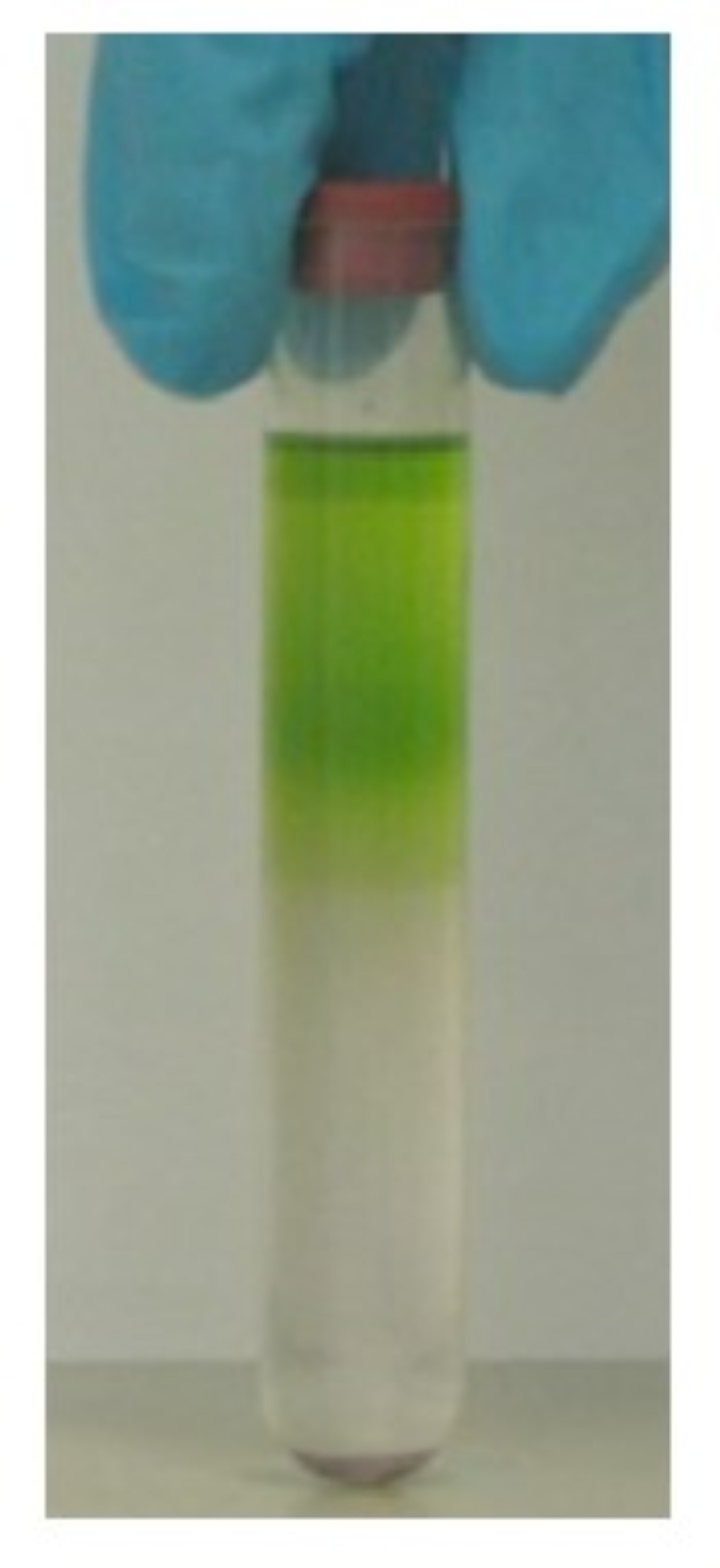Plant cells are heavily compartmentalized, and in the different reaction spaces, biochemical conditions vary substantially. To study metabolic pathways in different compartments, metabolite content must be analyzed in a compartment-specific manner.
This is not trivial, because during separation of compartments, metabolites can diffues or undergo chemical reactions.
A method that allows separation of compartments without the risk of metabolite changes is the "non-aqueous fractionation" technique: First, tissues are freeze dried to remove all water that allows diffusion or enzymatic reactions to take place. Then, the compartments are separated by density gradient centrifugation in organic, water-free solvents (see figure).
We use this method to study cellular metabolism at high spatial resolution. Only if compartmentation is taken into account, can we understand how metabolism is organized and regulated, and how cells can interact to form tissues and organs.
We could show that distribution of metabolites within a cell depends on environmental parameters. Soluble sugars like sucrose or the trisaccharide raffinose, for example, change their localization during cold acclimation of a plant. We could show that low temperatures cause raffinose to accumulate in plastids, where it is important for protection of photosystems during freeze-thaw cycles. Thus, raffinose is important for freezing tolerance of plastids.
But also during the "normal" growth phase, subcellular compartmentation has a strong impact on regulation of metabolism. Investigating the role of vacuolar invertase - an enzyme that cleaves sucrose into glucose and fructose - we found that the vacuole "buffers" metabolite concentrations in the cytosol and thus is important to stabilize metabolic homeostasis. In addition, allocation of sugars to either cytosol or vacuole is important in the regulation of sink/source relationships, because vacuolar sugars are not transported and thus remain in the leaf as carbons store for the night. Considering that sink organs, in many crop plants, are also the harvestable organs, subcellular compartmentation thus also influences yield.
We study the highly complex interaction of cellular compartments using mathematical methods of systems biology that allow simulation of transport processes, which are very difficult to analyze.
Relevant Publications
- Hoermiller, I.I., Naegele, T., Augustin, H., Stutz, S., Weckwerth, W., Heyer, A.G.: Subcellular reprogramming of metabolism during cold acclimation in Arabidopsis thaliana. Plant Cell Environ. 40, 602–610 (2017). https://doi.org/10.1111/pce.12836.
- Nägele, T., Heyer, A.G.: Approximating subcellular organisation of carbohydrate metabolism during cold acclimation in different natural accessions of Arabidopsis thaliana. New Phytol. 198, 777--787 (2013). https://doi.org/10.1111/nph.12201.
- Iftime, D., Hannah, M.A., Peterbauer, T., Heyer, A.G.: Stachyose in the cytosol does not influence freezing tolerance of transgenic Arabidopsis expressing stachyose synthase from adzuki bean. Plant Science. 180, 24--30 (2011). https://doi.org/10.1016/j.plantsci.2010.07.012.
- Wingenter, K., Trentmann, O., Winschuh, I., Hörmiller, I.I., Heyer, A.G., Reinders, J., Schulz, A., Geiger, D., Hedrich, R., Neuhaus, H.E.: A member of the mitogen-activated protein 3-kinase family is involved in the regulation of plant vacuolar glucose uptake. Plant J. 68, 890--900 (2011). https://doi.org/10.1111/j.1365-313X.2011.04739.x.
- Knaupp, M., Mishra, K.B., Nedbal, L., Heyer, A.G.: Evidence for a role of raffinose in stabilizing photosystem II during freeze--thaw cycles. Planta. 234, 477--486 (2011). https://doi.org/10.1007/s00425-011-1413-0.
- Nägele, T., Kandel, B.A., Frana, S., Meissner, M., Heyer, A.G.: A systems biology approach for the analysis of carbohydrate dynamics during acclimation to low temperature in Arabidopsis thaliana. FEBS J. 278, 506--518 (2011). https://doi.org/10.1111/j.1742-4658.2010.07971.x.
- Wingenter, K., Schulz, A., Wormit, A., Wic, S., Trentmann, O., Hoermiller, I.I., Heyer, A.G., Marten, I., Hedrich, R., Neuhaus, H.E.: Increased Activity of the Vacuolar Monosaccharide Transporter TMT1 Alters Cellular Sugar Partitioning, Sugar Signaling, and Seed Yield in Arabidopsis. Plant Physiol. 154, 665--677 (2010). https://doi.org/10.1104/pp.110.162040.


